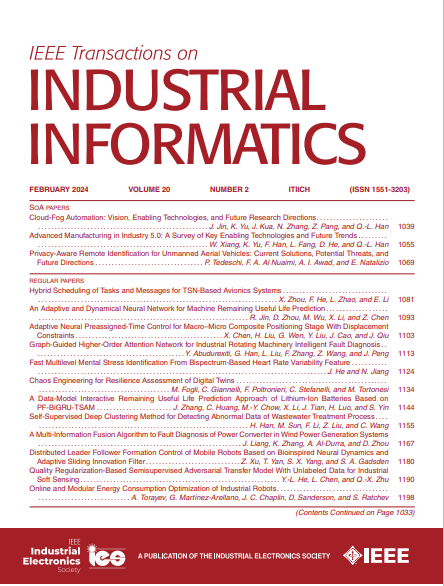Privacy-Preserving Lightweight Time-Series Anomaly Detection for Resource-Limited Industrial IoT Edge Devices
IF 9.9
1区 计算机科学
Q1 AUTOMATION & CONTROL SYSTEMS
引用次数: 0
Abstract
Identifying anomalies directly on edge devices rather than in the cloud, known as edge computing, is essential for Industry 4.0. However, the limited computing and storage resources on edge devices render traditional cloud-based anomaly detection models ineffective. To solve this issue, a privacy-preserving lightweight time-series anomaly detection model, named PPLAD, is proposed for resource-limited industrial Internet of Things (IoT) edge devices via global and local similarity discrepancy.资源有限的工业物联网边缘设备的隐私保护轻量级时间序列异常检测
直接在边缘设备上识别异常,而不是在云中识别异常,即边缘计算,对于工业4.0至关重要。然而,边缘设备有限的计算和存储资源使得传统的基于云的异常检测模型失效。为了解决这一问题,针对资源有限的工业物联网(IoT)边缘设备,利用全局和局部相似度差异,提出了一种保护隐私的轻量级时间序列异常检测模型PPLAD。首先,PPLAD直接使用数据相似度代替原始数据作为模型输入,实现隐私保护。其次,PPLAD采用可训练的高斯分布而不是深度神经网络作为模型结构,实现了高时效性和低成本。具体来说,PPLAD构建了一个可训练的高斯分布,每个时间戳只有一个参数,以模拟其与邻居的相似度。第三,提出了一种全局和局部对抗学习策略来放大每个时间戳的局部相似度和全局相似度之间的差异。最后,利用差异来准确识别时间戳级别的异常。据作者所知,这是第一个仅使用可学习的高斯分布构建工业异常检测模型的工作。在8个公共工业多传感器数据集和3个边缘设备上进行的广泛实验表明,PPLAD优于几种最先进的模型。
本文章由计算机程序翻译,如有差异,请以英文原文为准。
求助全文
约1分钟内获得全文
求助全文
来源期刊

IEEE Transactions on Industrial Informatics
工程技术-工程:工业
CiteScore
24.10
自引率
8.90%
发文量
1202
审稿时长
5.1 months
期刊介绍:
The IEEE Transactions on Industrial Informatics is a multidisciplinary journal dedicated to publishing technical papers that connect theory with practical applications of informatics in industrial settings. It focuses on the utilization of information in intelligent, distributed, and agile industrial automation and control systems. The scope includes topics such as knowledge-based and AI-enhanced automation, intelligent computer control systems, flexible and collaborative manufacturing, industrial informatics in software-defined vehicles and robotics, computer vision, industrial cyber-physical and industrial IoT systems, real-time and networked embedded systems, security in industrial processes, industrial communications, systems interoperability, and human-machine interaction.
 求助内容:
求助内容: 应助结果提醒方式:
应助结果提醒方式:


